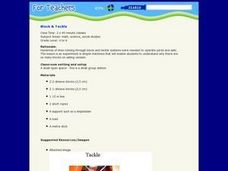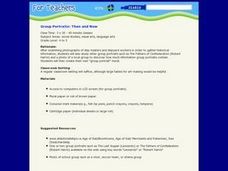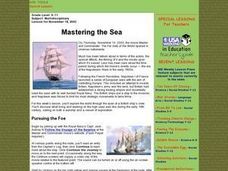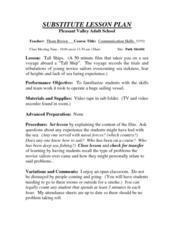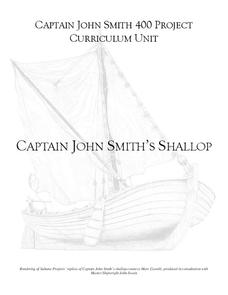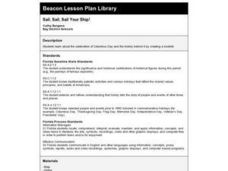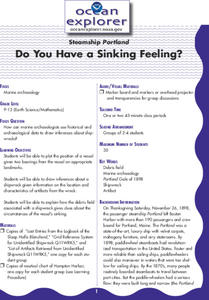Curated OER
Sailing Vessel Contour Creations
Students explore different types of sailing vessels and the rigging, sails, masts. They discuss contour lines and how they can be used to create a portrait of a sailing vessel then they choose a sailing vessel image as a reference to...
Curated OER
Sailing Vessel Postcards
Young scholars research a sailing vessel. They create sailing vessel postcards which include research information they located. Students also include any experiences they may have had on a sailing vessel.
Curated OER
Ship-Fish or Fish-Ship
Students read two books about fishing and ships. After viewing portraits, they identify and describe the various types of sailing vessels. They discuss how the artist showed water and detailed the areas around the ships. They create...
Curated OER
Act-It-Out Columbus Boat
Students investigate the trip Christopher Columbus took to the new world. In this U.S. History lesson, students create a fictional ship from cardboard and construction paper simulating the ship Columbus used to get to the New...
Curated OER
My First Biography: Christopher Columbus Storia Teaching Guide | Scholastic.com
Sail with Christopher Columbus on a biographical reading adventure. Young explorers learn about the life of Sir Columbus as they hone their comprehension skills through guiding questions, shared reading, and fluency practice. Included in...
Curated OER
Sailors and Sharks
Learners use the skills of fleeing and dodging in order to avoid being tagged. They begin standing on the ships (mats). One student, the shark, wears a pinney. At the signal from the teacher of "Sailors swim", the sailors scatter to a...
Curated OER
Block & Tackle
Learners participate in a lab experiment in which they discover the need for so many blocks and tackles on sailing ships. In groups, they make and test their predictions and practice measuring objects in various units. They record and...
Curated OER
Measure for Measure
Young mathematicians work to recognize the relationship between their scale models of the Joides research vessel and the real vessel. They calculate the relationships between various parts of the ship using fractions, ratios, and...
Curated OER
Group Portraits: Then and Now
Students use photographs to examine ship masters and shipyard workers. As a class, they explore other group portraits and discuss the information that can be found from the photos. As a group, they create their own group portrait mural.
Curated OER
Welcome Aboard the Newport
High schoolers work in groups to create a book for a museum setting that introduces the tall ship, the Newport, to the public. They conduct research on maritime heritage and examine the responsibilities accociated with sailing.
Curated OER
Mastering the Sea
Students investigate what life was like on early 19th century ships. They participate in a Webquest, explore the website for the movie, 'Master and Commander,' watch movie excerpts, take an interactive tour of a ship, and answer...
Curated OER
I Saw A Ship A-Sailing
Students engage in a lesson that is concerned with the reading of the story while focusing upon the development of vocabulary and reading fluency. They practice reading while running their finger underneath the text to follow along with...
Curated OER
Naval Battles in the Age of Sail
Students compare and contrast British and American/Allied naval losses during the American Revolution. They recognize factors affecting the outcome of a naval battle and describe a naval battle from the age of sail.
Curated OER
Recycled Sailing Vessels
Students discuss how recycled materials can be used to create art and how this will apply to their artwork. They create a sailing vessel using recycled materials that they find.
Curated OER
The Age of Sailing Songs
Students explore various genres of spoken and written expression. While considering the era of the shipyard and sailing, students describe and document a favorite ship, captain, crew, or life of a sailor. Using this information, they...
Curated OER
Tall Ships
Students watch a videotape about a voyage aboard a "tall ship." They watch as young, inexperienced sailors overcome seasickness, fear, and lack of experience and come together as a team to operate the sailing vessel. They discuss the...
Curated OER
Captain John Smith's Shallop
Young explorers, all aboard the shallop to discover how early European explorers would navigate the American coastline to find resources, map terrain, and trade with Native American tribes.
Curated OER
Voyages in a Bottle
Students uncover the method for easily building a ship in a bottle. Then they fabricate a 3-D model of the ship(s) used on an exploratory sailing voyage and display it in a plastic bottle. Students also draw a map of the world their...
Curated OER
Follow That Ship!
Students in this exercise are introduced to the distinct ways of measuring distance (nautical miles) and speed (knots) at sea, as well as the concepts of latitude and longitude for establishing location.
Curated OER
Sail, Sail, Sail Your Ship!
Students listen to the book, Columbus Day, by Paul Showers and discuss the historical significance of Christopher Columbus. They create Columbus Day booklets, sing a Christopher Columbus song, and develop graphic organizers.
Curated OER
Organic Vessels
Students review the life and work of Andy Goldsworthy. Using this information, they gather organic objects to create their own sailing vessel. They reflect on their artwork and determine what problem their artwork solves.
Curated OER
Africa: The Middle Passage and 19th Century America
Students participate in a series of activities to explore the lives of slaves in 19th century America. They examine the design of slave ships, the hardships endured, and the ways that owners depended on slaves for their economic survival.
Curated OER
Tonnage - Measurement
Students explore the size of one ton. They research the capacity of sialing ships and estimate the volume of rectangular prisms. Students perform activities to discover the capacity of a classroom in tons.
Curated OER
Do You Have A Sinking Feeling?
Students plot the positions of vessels given bearings in the form of landmarks. They explain how the debris field can help solve the mystery in how the ship sunk.






